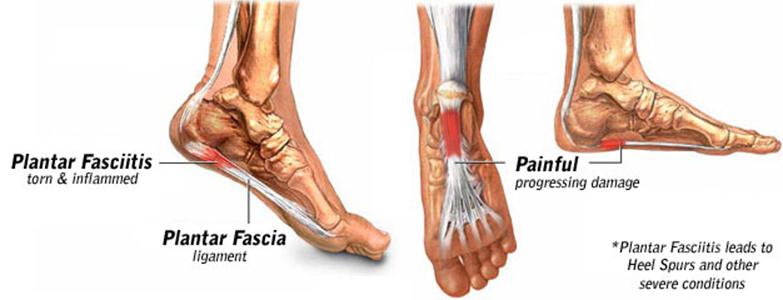Although I knew that my suspicions would be confirmed, I visited with an orthopedic surgeon yesterday. Just like Christopher McDougall, author of Born to Run, I wanted to ask the same question "Why do my feet hurt?" X-rays of my foot were clear, which was a positive, but the doctor told me it was the dreaded plantar. Stretching was the way to cure the problem initially, plus REST!?!? Another thing a runner hates to hear. He advised more cross-training, as well. Should the pain get unbearable, we could consider cortisone injections and maybe even surgery. Yikes.
So what is plantar fasciitis?

Image from www.strengthrunning.com
It is an inflammation of the plantar fascia, or the tissue that connects on the sole of your foot. According to studies, this problem occurs due to overuse of the plantar fascia, or arch tendon of the foot. If not looked at properly, this condition can become difficult to treat, so take this injury SERIOUSLY, runners! Longstanding cases of this condition can often lead to more degenerative changes than inflammatory changes, which are known as plantar fasciosis. Tendons and ligaments such as the plantar fascia do not contain blood vessels. As a result, that "inflammation" is really the result of an accumulation of microscopic tears at the cellular level, developing over time.
Why Do I Get It?
You are most likely to experience plantar fasciitis if: (1) you have foot arch problems (a high arch like me or a flat foot like Mickey); (2) long-distance running, especially running downhill or on uneven surfaces; (3) sudden weight gain or obesity; (4) a tight Achilles tendon or (5) shoes with poor arch support or soft soles. Make sure to invest not only in your shoes, but in a good pair of insoles!
What Are the Symptoms?
Beware of pain and stiffness in the bottom of the heel. The pain will most typically be a dull or sharp pain. The bottom of your foot may also ache or burn. Your pain will usually be worse in the morning when you take your first steps, after standing or sitting for a while, while climbing stairs, or after intense activity. For me, I feel the most pain will walking in flat shoes, so I stay in heels all day to relieve the pain.
How Can It Be Treated?
For me, the doctor advised me to stretch my calf and foot at least 6 times a day by pressing against the wall like a typical calf stretch. Push the foot hurting you back a few feet behind you and turn the foot, with toes facing inward at a 45 degree angle. Hold that pose and feel the stretch in your calf and foot arch. You can do a similar stretch with a plantar fasciitis relief rocker ($39.95 at most stores). I like the free option myself.
You can also do the following: (1) take ibuprofen or other over-the-counter pain reliever; (2) wear a night splint to bed while sleeping to stretch the foot (these can get pricey!); (3) rest as much as possible for a week; (4) try cross-training as a form of exercise; and (5) wear shoes with good support. You can also apply ice to the area, which has worked for me.
Cortisone Injections
Be wary of the "quick fix" effects of a cortisone shot and do your research prior to getting one. There are several studies that have come out regarding the negative side effects of these injections, including infection to the area.

No comments:
Post a Comment